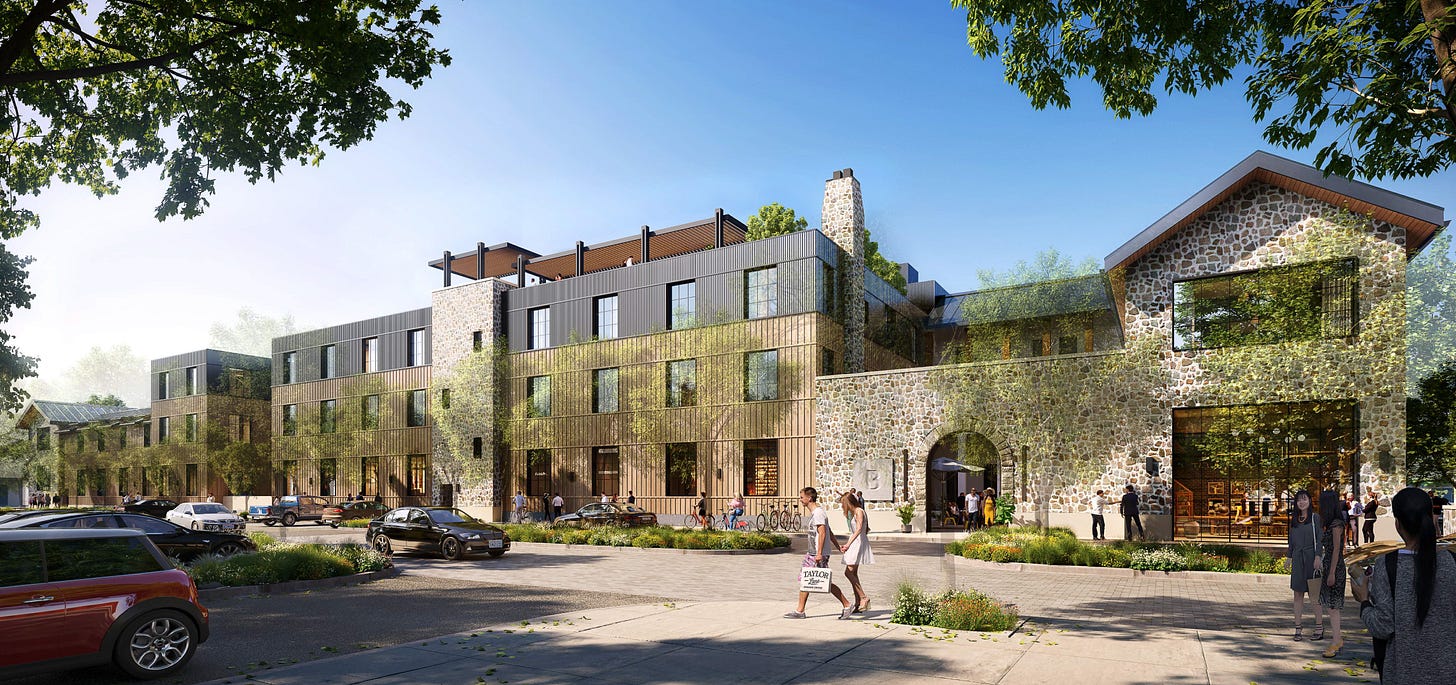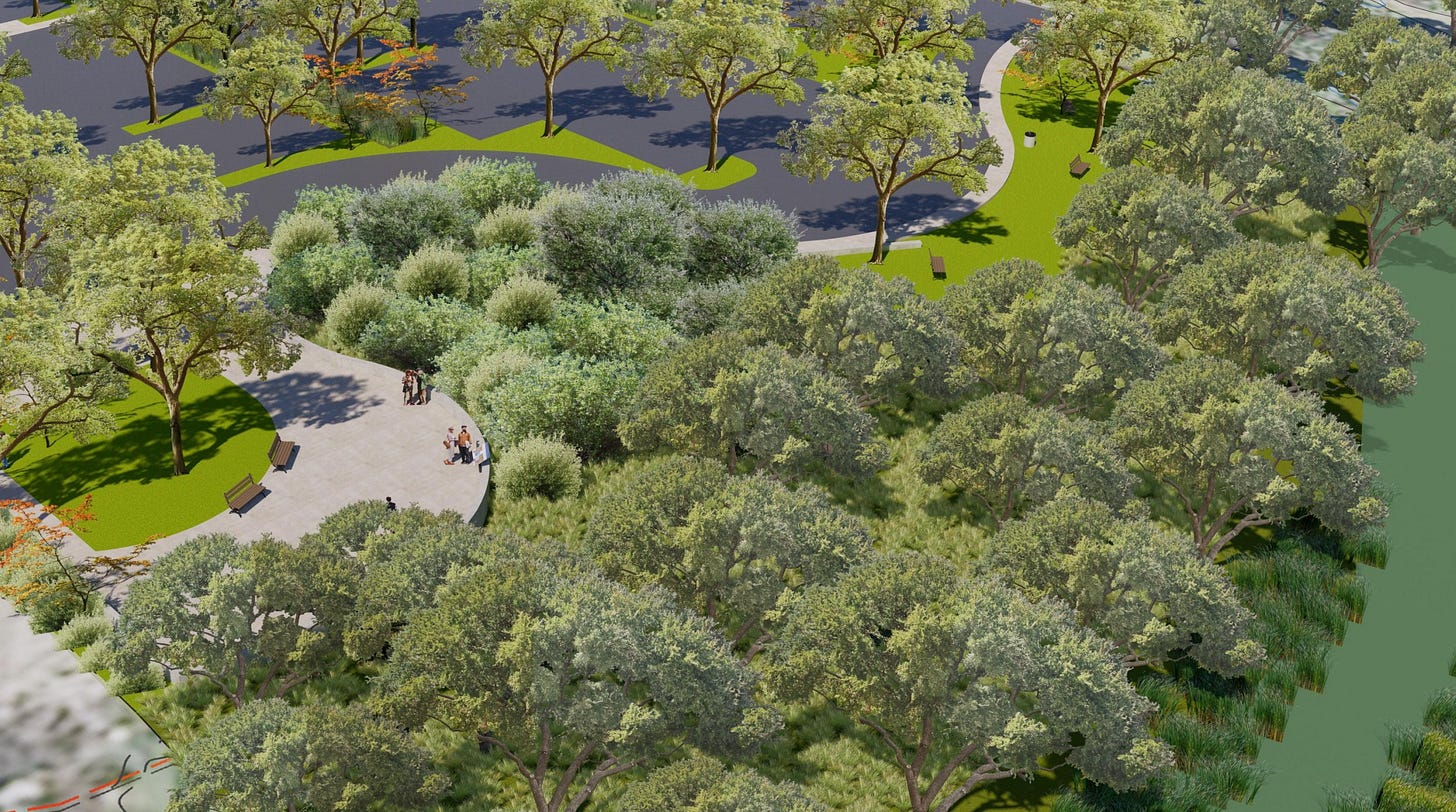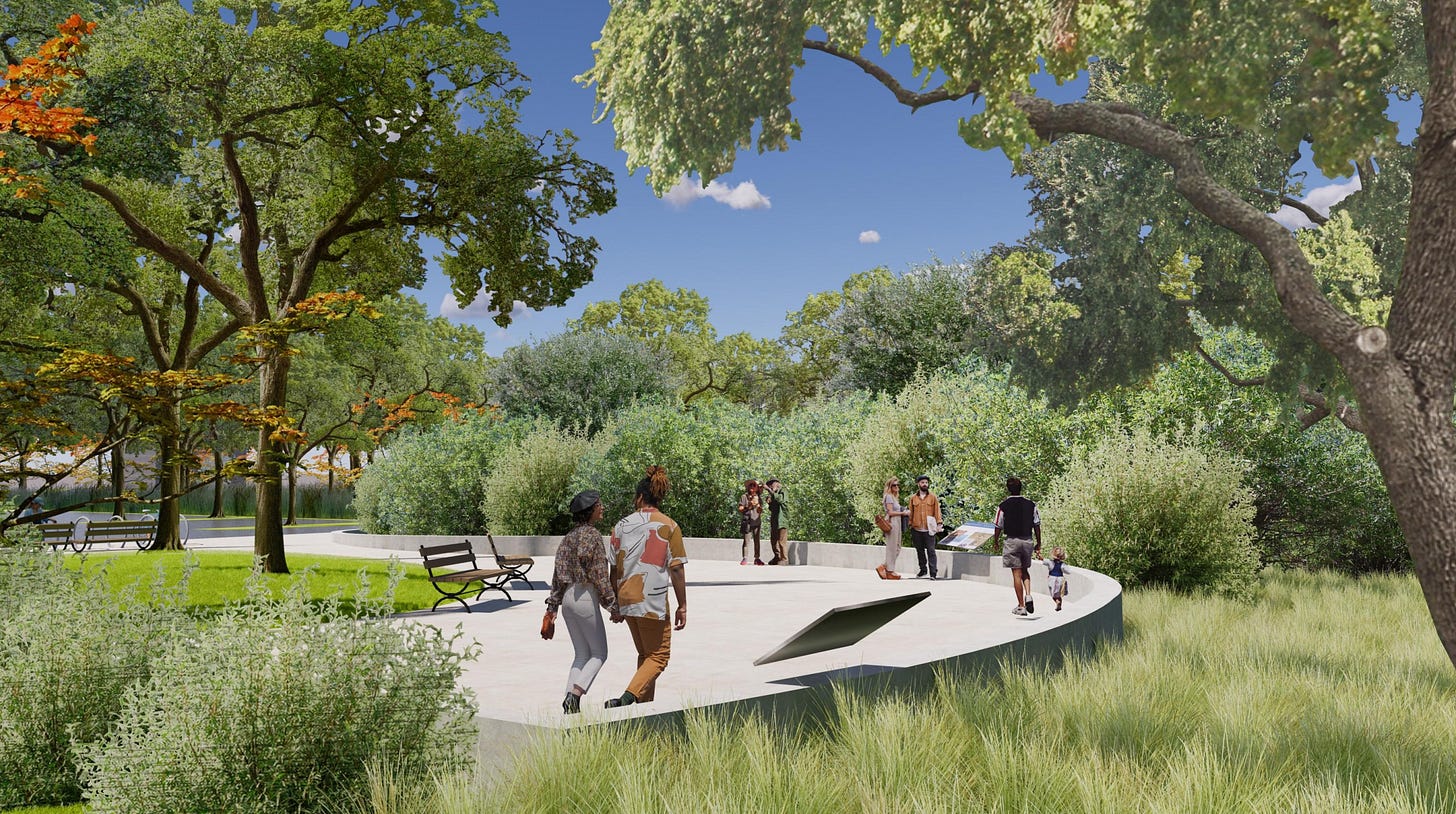Planning Commission gives its nod to the Barlow Hotel
A spiffy new design and a city ready to make a deal

On Tuesday evening, March 25, the Sebastopol Planning Commission and the Design Review Board held a rare joint meeting to review the new Barlow Hotel development, a project of Barlow owner Barney Aldridge’s development company.
The project, which is located at 6782 Sebastopol Avenue, consists of a hotel with up to 83 rooms and a maximum height of 55 feet, with a rooftop pool and cafe. On the ground floor, the hotel will also include a restaurant, a spa, retail space, and meeting rooms. The new hotel would replace the existing Guayaki building and would redevelop the parking area between that building and Community Market. The project also includes the development of an offsite parking lot at 385 Morris Street, which will include 232 parking spaces with a mix of valet, regular, and EV parking.
The city of Sebastopol is fast-tracking this development in hopes of getting it built as soon as possible so that the TOT taxes and additional sales taxes from guest shopping can buoy the city’s sagging bottom line.
The purpose of Tuesday night’s meeting was for the Design Review Board (DRB) to provide comments to the Planning Commission, which would then consider the project’s proposed development agreement and provide a recommendation to the Sebastopol City Council, which has the final say.
On Tuesday, the planning commission voted unanimously to approve the development agreement for the Barlow Hotel. The actual vote was 4 yeas to 1 recusal. Planning Commission Chair Paul Fritz recused himself because he has done architectural work for the Barlow over the last few years.
The Sebastopol City Council will discuss the Barlow Hotel development at their April 14 council meeting.

The first time the planning commission got a look at this hotel in July 2024, the design was less than inspiring, but, my goodness, how things have changed. The new design won near universal acclaim from the members of the planning commission and the DRB. (The sole skeptic was DRB member Lynn Deedler, who complained that the hotel didn’t look like the rest of Sebastopol—but even he said he supported approving the project.)

Planning Commissioner and architect Seth Hanley said, “I think this is going to be a great amenity for Sebastopol, and I’m excited to see it added to the town. I think it’s going to bring people and revenue, which we obviously need. We have a need for another hotel. I think this is the best use for this site. It’s certainly better than what's there now. I think the Barlow development’s been very successful, and I have no doubt that this will add to its success and be a success in itself.”
There were some quibbles—the main one being that the part of the hotel facing Sebastopol Avenue looked like the back not the front of the building, which is problematic because, as many at the meeting said, Sebastopol Avenue is a gateway into the city—and right now it’s in pretty poor shape.
Adjunct Planner Jane Reilly, who is overseeing the Barlow Hotel project, summed up the group’s comments this way, “It [Sebastopol Avenue] sets the tone. Consider it an important gateway. The project can go further in engaging Sebastopol Avenue, and that frontage still needs some improvement.”
The project’s architect, Ian Murphy, said his firm, BDE Architecture, would take another look at that portion of the building, which is currently designed to house the hotel spa.
There was some discussion about how to connect the hotel and the Barlow in general to the shops on Main Street, a point raised by Planning Commissioner Jennifer Koelemeijer. In response to this discussion, Lars Langberg, the chair of the DRB, said, “It’s not the Barlow’s responsibility to invigorate Main Street. I think the Barlow is setting a great example in just doing what it’s doing.”
Both the planning commission and the DRB seemed pleased with the Barlow’s plans to develop the old Batch Plant property into a parking lot with a curving promenade along the edge of the laguna. The 232 parking spaces would be evenly divided between hotel guests, Barlow workers, and Barlow visitor parking.
“I think the batch parking is a great addition, and I think it’s been very thoughtfully designed,” Hanley said.
Another discussion highlighted a rather significant difference in the financial projections by the developer and the city about how much money the project would ultimately bring the city of Sebastopol via transit occupancy tax (TOT), as well as increased property and sales taxes.
Two studies about the financial impact of the hotel on the town were discussed at the meeting. The study by RRC Associates was provided by the Barlow, and the study by Economic and Planning Systems was commissioned by the city of Sebastopol. The discrepancy was described in the city’s staff report:
In general, the RRC study provides higher projected revenues to the City, and the EPS Study provides significantly more conservative figures…Study estimates of the projected financial benefits to the City are shown in Table 3 below. Note that they assume that the hotel is fully operational, which is expected to take about five years from opening.
The city’s economic consultant Jason Moody of EPS said, “Our expectation is it will be somewhere in between there.”
During public comment, several Barlow business owners came to show their support for the project. Tim Hedges of Vanguard Properties in the Barlow explained why it was needed.
“I just have a couple of real-life examples. We hosted a retreat for our company in Sebastopol about six months ago…and it was planned as an overnight retreat. Initially, there are like 30 people, but as we looked more closely, there was nowhere for anyone to stay. So it turned into a one-day retreat, which was unfortunate, because those 30 people, leaders in our company, would have stayed here and enjoyed local restaurants and spent money at local stores. So this [hotel] would allow that to happen…Also, oftentimes we have people looking for homes in West Sonoma County, and they want to come spend the weekend in Sebastopol. There’s nowhere to stay besides an Airbnb. They can’t really immerse themselves in our town. They can’t feel it. Oftentimes they end up in Healdsburg or Sonoma or Santa Rosa. So I think this would be a fantastic opportunity.”
Leah Wilner, a Sebastopol resident who lives near the Barlow, commended the project, but also asked the city to not let the tail wag the dog. “Kudos to the Barlow, but as a town, don’t let Sebastopol become defined by the Barlow. Make sure that there are other things that are desirable to do.”
Kirk Lok, the owner of the Fairfield Inn and Suites at the south end of town, submitted a letter of support for the project. “Mr. Aldridge has proven to be a very resourceful developer—for him to reimag[ine] an old apple processing facility into the Barlow Center today. I think his 83-room hotel at the Barlow will be a great asset to Sebastopol and provide our vibrant food and beverage scene a healthier infusion of weekday traffic to support their endeavors. People thought I was nuts to build an 82-room hotel in 1998, in, of all cities, Sebastopol. Well, we are still here, and we welcome Barney’s Barlow Hotel.”
The city is very eager to get this project moving. City Manager Don Schwartz said, “We have been working closely with the applicant in a collaborative manner, as well as having a city team that has worked well together on this. That we’re doing this with a Development Agreement—which is common for projects of this scope—is likely helping to move things forward more quickly.”
Regarding the question of fast-tracking, Schwartz said, “We have made this a priority for months. We know that economic development is important to the council, and this project is our top priority for economic development. It will also support existing local businesses, another priority.”
In addition to the promised economic boost, the city also expects to collect just under a million in development fees from the hotel project, according to Planner Jane Reilly.
According to Barlow representatives, the estimated timeline for development looks like this:
April 2025: city council meeting
May 2025: design and construction drawings would proceed
Third and fourth quarter 2025: building permit submittal
Fourth quarter 2025 to first quarter 2026: building permit approval
First quarter 2026: construction start
Third and fourth quarter 2027: construction completion
The planning commission’s approval—and presumedly the council’s approval—are just the first of many hoops that Aldridge Development will have to successfully negotiate to see the project through to completion.
According to DRB member Christine Level, who is building her own small project in downtown, the next step after city council approval is for Aldridge to get the financing in place to build his multi-million dollar hotel project. This step has proved thus far to be a nearly insurmountable hurdle for the developers of the nearby proposed Hotel Sebastopol. City officials are hoping that Aldridge will have better luck.
See the meeting video and documentation here.





As someone who lives in town, generally speaking, The Barlow is for people visiting town and Main St and beyond is for us who live in West County. I do not go to the Barlow at all (except to visit Sarmentine). When I read "Lars Langberg, the chair of the DRB, said, “It’s not the Barlow’s responsibility to invigorate Main Street. I think the Barlow is setting a great example in just doing what it’s doing.”' it boiled my blood a little because the Barlow isn't really doing much for the people who live here besides an easy way to balancing the budget, but I also agree in a different way that I don't want Sebastopol to become the Barlow. And I don't want the rest of our town to be left behind, which I got that feeling from Lars' quote. With this hotel I think the Barlow will become more insular and become Healdsburg. I grew up in Healdsburg and it is a completely different town now from 20 years ago. When you're just looking for ways to make money you will cater to the people who have money and their tastes, instead of highlighting what makes a place special and unique. It's very White Lotus. Also wanted to note that regarding concern for the gateway to the town, we have a giant "Cock" to greet folks... Are we in Petaluma?
Was there any discussion of flood control - of the fact that the eastern edge of the building is just about on the edge of the 100 year flood line? Given Barney Aldridge's failure to control the last flood crisis in 2019 what assurance is there that another, perhaps even more severe, flood will be adequately controlled?